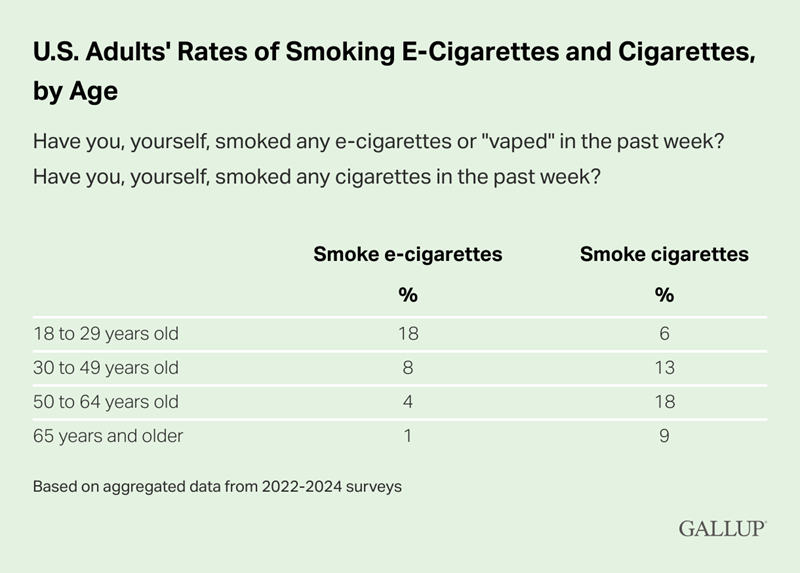US smoking rate hits historic low as young adults drive decline
Cigarette smoking has fallen to 11%, but vaping is becoming more popular, especially among those under 30

Cigarette smoking in the United States has reached a historic low, according to Gallup's latest findings.
Currently, just 11% of US adults report having smoked cigarettes in the past week, matching the all-time low recorded in 2022, and nearly matched by the 12% figure in 2023. This marks a significant decline from 1944 when 41% of adults said they smoked. The current smoking rate is about half of what it was a decade ago and just one-third of the rate in the late 1980s.
Gallup’s annual Consumption Habits poll, conducted from July 1-21, highlights this downward trend. Between 1944 and 1974, at least 40% of adults consistently reported smoking cigarettes. Today, that figure has dwindled to barely one in 10.

One of the primary drivers behind the decline in cigarette smoking is the dramatic decrease in smoking rates among young adults, historically the age group most likely to smoke. Over the past three years, an average of just 6% of adults under 30 reported smoking cigarettes in the past week, a stark contrast to the 35% who smoked during the 2001-2003 period.
Young adults are now the least likely age group to smoke cigarettes, with 13% of those aged 30 to 49, 18% of those aged 50 to 64, and 9% of those 65 and older reporting that they smoke.
Smoking rates continue to correlate with educational attainment. Among college graduates, only 5% report smoking cigarettes, compared to 15% of those without a college degree. These rates have also declined significantly since the early 2000s, when 14% of college graduates and 30% of non-graduates smoked.
While traditional cigarette smoking has declined, vaping has emerged as a new trend, particularly among younger adults. Currently, 7% of US adults report having used e-cigarettes or “vaped” in the past week. This rate has remained steady, ranging between 6% and 8% since 2019.
Young adults, who are now the least likely to smoke cigarettes, are the most likely to vape. 18% of those aged 18 to 29 report vaping, with usage rates declining progressively among older age groups, down to just 1% of those 65 and older.

Educational differences in vaping are minimal, with 5% of college graduates and 9% of non-graduates reporting usage.
The generally low rates of cigarette and e-cigarette use may be influenced by widespread perceptions of harm. A substantial 79% of US adults believe cigarettes are “very harmful” to those who use them, and 57% hold the same view about e-cigarettes.
Chewing tobacco is also widely viewed as harmful, with a majority of adults considering it “very harmful,” though fewer people see cigars, pipes, or nicotine pouches as equally dangerous. However, at least seven in 10 Americans believe all these substances are “somewhat harmful.”
Those who smoke or vape are less likely than non-users to view their chosen substance as harmful. While 58% of cigarette smokers consider smoking very harmful, 80% of non-smokers share this view. Similarly, 63% of vapers see e-cigarettes as very harmful, compared to 79% of non-vapers.

The decline in cigarette smoking to an 80-year low in the US reflects the success of public health campaigns and growing awareness of the health risks associated with smoking. Young adults, in particular, have driven this change, reversing historical trends that saw them as the most likely to smoke.
However, this positive trend is tempered by the rise of e-cigarette use among the same demographic. Roughly three times as many young adults now vape as smoke cigarettes. Although vaping is less harmful than traditional smoking, public health officials remain concerned about its potential long-term impact.
If current trends persist, vaping could surpass cigarette smoking as the more prevalent habit among US adults.











1726134115-0/BeFunk_-(41)1726134115-0-208x130.webp)







COMMENTS
Comments are moderated and generally will be posted if they are on-topic and not abusive.
For more information, please see our Comments FAQ